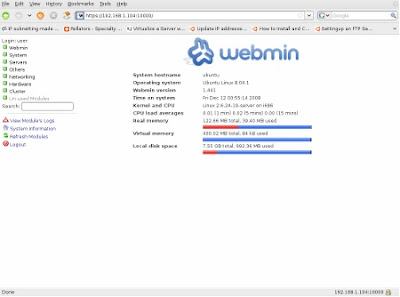How To Install Webmin On Ubuntu
Webmin is a web based interface for system administration of common services like Apache, DNS and file sharing among many others. The installation is simple and straight forward. Keep in mind that Webmin is available in tar.gz, .rpm, .deb and pkg.gz for your specific Linux distribution, for this How-To I will use the .deb package used in Debian based systems and tar.gz which should should translate to other Linux distributions. 
.deb installation
Download the .deb from the Webmin site.
wget http://prdownloads.sourceforge.net/webadmin/webmin\_1.441\_all.deb
Install Webmin.
sudo dpkg -i webmin_1.340_all.deb
If the system complains that some libraries are missing issue the following command.
sudo apt- get install -f
And login with the user name and password of a user with privileges in the system.
Installation complete.
.tar.gz installation
Download the Webmin tarball to (locations depends on preference), Visit the Webmin site for newer versions.
cd /usr/local
wget http://prdownloads.sourceforge.net/webadmin/webmin-1.441.tar.gz
and untar.
tar zxvf webmin-1.441.tar.gz
Move to the newly created directory.
cd webmin-1.441
and execute the install script.
./setup.sh
When completing the install use common sense and change the default port. Some of the questions to be answered are :
Config file directory [/etc/webmin]:
Log file directory [/var/webmin]:
Full path to perl (default /usr/bin/perl):
Web server port (default 10000):
Login name (default admin): user
Login password: user
Password again: user
Use SSL (y/n): y
Start Webmin at boot time (y/n): y
And login with the user name and password you entered previously.
In case you decide to uninstall Webmin issue the following commands.
cd /etc/webmin/
sudo ./uninstall.sh